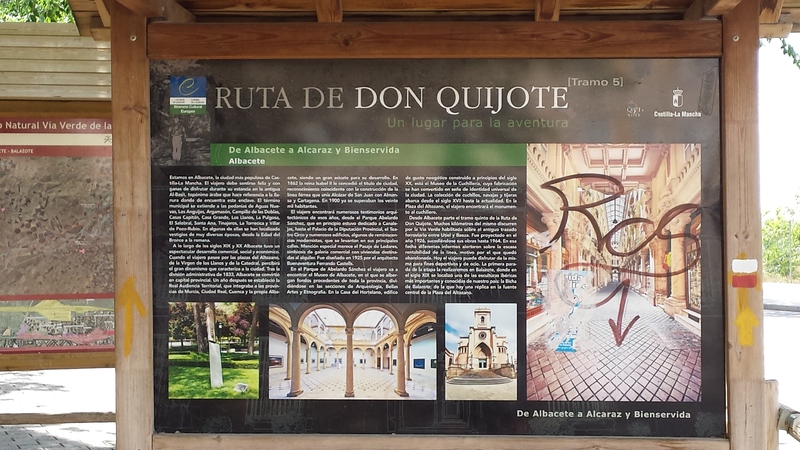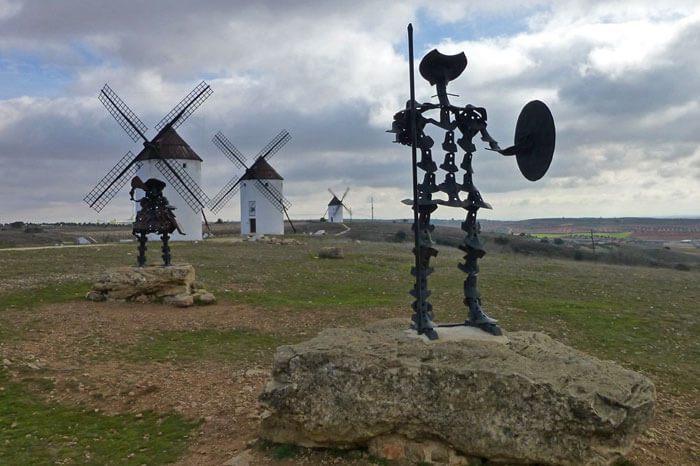Reaching Outside of Fiction: Don Quixote through Tourism
“La Ruta de Quijote” follows the path of Miguel de Cervantes’ Don Quixote and Sancho Panza in their various sallies. Geographic and cultural clues have allowed scholars such as John Bowle and Jose Romagosa Gironella, whose version was accepted by the Real Academia Española, to attempt to trace out the adventure, from La Mancha to the Sierra Morena to Zaragoza and Barcelona. The creation of such routes has allowed the different cities and towns within Spain to represent the Quixotic and Cervantine presence through tourism. For instance, the sign featured below in Albacete welcomes travelers to their stop on the path and describes the city, a bit of its history and cultural contributions, as well as its presence within the story.
One of the most famous escapades of the famous knight Don Quixote is his experience with the windmills, which he perceives to be giants. This finds its second life in its recreation along the Ruta de Quijote in Mota del Cuervo. As in the iconic moment of the book, Don Quixote and Sancho Panza are immortalized as statues amongst a sea of windmills, Quixote holding his lance, ready to attack, and Sancho looking on while drinking from a wineskin. This represents the contrast largely typical to this book of readiness versus reluctance in its main characters. In this way, though it is a reference to a specific part of the book, it is a window into it as a whole.
The Ruta de Quijote permits readers of the book to experience and participate in the recreation of its content. Cervantes’ novel itself is based in the idea of a book-lover being so caught up in his stories of knight errantry that he begins to believe they are real and decides to become one such knight errant. As he goes out to recreate the adventures that he read, readers are strongly reminded of the difference between fiction and reality, and his lack of cognizance to this concept proclaims him as mad. However, there is something very human in this character’s preference to the recreation over the real. While scholars such as Egginton and Nabokov relate Don Quixote as a grand endeavor in its time, even the first real novel given that it draws readers in, today we are able to see its lasting impact as readers still want to pursue the fictional. Perhaps one of the lessons of the book is being ignored through this process, but the Ruta de Quijote is followed by those who believe in the reality of fiction and add a layer of madness to their lives, just as Quixote himself did.
“La Ruta de Quijote” sigue el camino de los personajes de Miguel de Cervantes, Don Quixote y Sancho Panza, en sus varias expediciones. Pistas geográficas y culturales han permitido a académicos como John Bowle y Jose Romagosa Gironella intentar a rastrear la aventura, de La Macha a la Sierra Morena a Zaragoza y Barcelona. Esta ruta ha recibido el visto bueno de la Real Academia Española. La creación de rutas del Quijote ha permitido a ciudades y pueblos de España asumir la presencia del Quijote y Cervantes a través del turismo. Por ejemplo, el cartel que aparece abajo, está en Albacete, donde se da la bienvenida a visitantes en su parada de la ruta y da información de la ciudad, un poco de su historia y contribuciones culturales, además de su presencia en la novela.
Una de las aventuras más famosas del famoso caballero es su experiencia con los molinos de viento, que el percibido a ser gigantes. Esto se encuentra su vida segunda en su recreación en la Ruta de Quijote en la Mota del Cuervo. Como en el momento icónico en el libro, Don Quixote y Sancho Panza son inmortalizados como estatuas entre un mar de molinos, Quixote con su lanza, preparado para atacar, y Sancho con su bota, mirando. De este modo se representa un contraste muy típico en el libro- el atrevimiento del hidalgo y la del escudero. De esta manera, aunque representa una parte especifica del libro, funciona como una ventana al libro total.
La ruta del Quijote permite a lectores del libro a experimentar y participar en la recreación de su contenido. La novela de Cervantes está basada en la idea de un amante de libros tan absorto en sus lecturas de caballeros andantes que empieza a creer que son reales y decide convertirse en uno de estos caballeros. Cuando él sale para recrear las aventuras que ha leído, los lectores aprenden la diferencia entre la ficción y la realidad. El hidalgo, en cambio, su falta ignora las diferencias, lo cual nos muestra que está loco. Sin embargo, hay algo muy humano en la preferencia de este personaje a la recreación por encima de lo real. Mientras académicos como Egginton y Nabokov aprecian en Don Quijote la primera gran novela moderna porque atrae precisamente a sus lectores, hoy podemos ver su impacto duradero porque los lectores todavía quieren seguir la ficción. Quizás una de las lecciones del libro se ha ignorado a través del proceso, pero los que siguen la Ruta de Quijote creen en la realidad de la ficción y añaden una capa de locura a las vidas, justo como Quijote mismo hizo.
--Bethany Mathews


